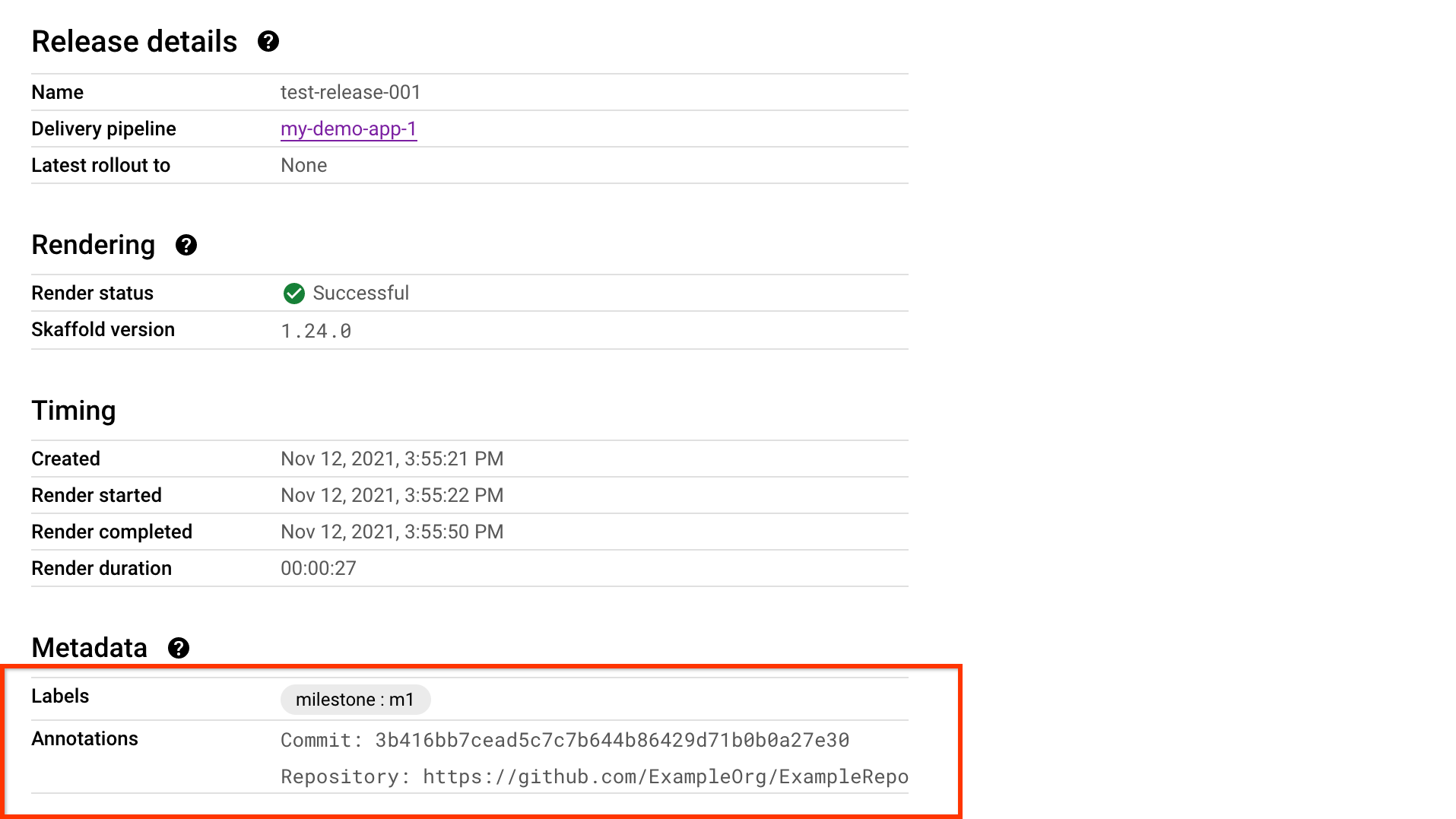You can attach annotations and labels to your Cloud Deploy resources. They're not required.
This document lists the resources to which you can attach labels and annotations, and describes how you can use them and where you can view them.
About annotations and labels
Annotations are key-value pairs of free-form text. You can use them to attach arbitrary information associated with the resource.
You can use labels to organize resources. For example, you can apply logic based on label selection.
As with annotations, labels are key-value pairs. But they must conform to the following limitations:
A Cloud Deploy resource can have no more than 64 labels.
Keys and values both must be 128 bytes or less.
Keys and values can contain only lowercase letters, numeric characters, underscores, and dashes.
Keys must start with a lowercase letter or international character.
All characters must use UTF-8 encoding. International characters are allowed.
The --labels flag (for example, on gcloud deploy releases
create) can take a list of key-value pairs:
"name=wrench,mass=1.3kg,count=3"
See the Cloud Deploy API documentation for more details.
Adding annotations and labels to Cloud Deploy resources
You can add annotations and labels to the following Cloud Deploy resources:
Delivery pipelines
For delivery pipelines, you add annotations and labels to the YAML configuration file.
apiVersion: deploy.cloud.google.com/v1
kind: DeliveryPipeline
metadata:
name:
annotations:
key: "value"
labels:
key: "value"
description:
serialPipeline:
stages:
- targetId:
profiles: []
- targetId:
profiles: []
Targets
Add annotations and labels to targets in the target configuration YAML.
For example, you can include a link to more information about third-party monitoring for your application. However, if the target is shared, remember that it could be used for more than one application, so the link should not be application specific.
Releases
You can add annotations or labels, or both, to a release using the
--labelsand--annotationsflags on thegcloud deploy releases createcommand. Labels and annotations you add to a release are not carried forward as labels or annotations on resulting rollouts.For example, you can use annotations to include a reference to a Git PR, author, or SHA hash of the Git commit containing the changes to be deployed. See Using annotations to track the release's provenance for more details.
Rollouts
You can add annotations and labels to new rollouts by specifying
--labelsor--annotationson thegcloud deploy releases promotecommand.The only way to add annotations and labels to the first rollout is to create a rollout using the Cloud Deploy API, and include the annotations or labels in the
rolloutresource.Some things you can do using annotations on a rollout:
- Create an annotation containing the URL pointing to test results.
- Create an annotation with a relevant ticket number from a workflow management system.
Where can I find a resource's annotations?
You can view annotations and labels for any supported resource using the
resource's describe command or by viewing the resource's metadata in
Google Cloud console.
From the gcloud CLI
To view a resource's annotations and labels from the command line, use a
describe command on that resource. The following example shows the details
for a target:
$ gcloud deploy targets describe qsprod --delivery-pipeline=my-demo-app-1 \
--region=us-central1 \
--project=quickstart-basic8
The above command returns the following output:
Target:
annotations:
approver_ticket_queue_url: https://workflows.example.com/deploy_approvals/4985729
createTime: '2021-10-28T19:33:56.907887878Z'
description: development cluster
etag: 5b3bbee48f693cd7
gke:
cluster: projects/quickstart-basic8/locations/us-central1/clusters/quickstart-cluster-qsdev
name: projects/quickstart-basic8/locations/us-central1/targets/qsdev
uid: 3f3a5f8e7e0648e3bb17898ee531455d
updateTime: '2021-11-10T16:55:11.502660604Z'
Notice that this output includes the target_name annotation.
In Google Cloud console
To view annotations and labels for any Cloud Deploy resource that has such metadata, view that resource's details in Google Cloud console.
For example, here are the delivery pipeline details for a pipeline that includes an annotation:

And here are the details for a release:

Automatic labels from Cloud Deploy
By default, Cloud Deploy adds the following labels to rendered manifests:
app.kubernetes.io/managed-by:A standard label to indicate deployment tooling. This is always set to
google-cloud-deployto identify the origin of the workload.deploy.cloud.google.com/location:The location of the deployed delivery pipeline, for example
us-central1.deploy.cloud.google.com/project-id:The project ID of the deployed delivery pipeline.
deploy.cloud.google.com/delivery-pipeline-id:The resource ID of the delivery pipeline used. This is taken from the release snapshot.
deploy.cloud.google.com/release-id:The resource ID of the deployed release.
deploy.cloud.google.com/target-id:The resource ID of the deployment target. This is taken from the release snapshot.
Example usage
One example of using these automatically applied labels would be to create a graph within Google Cloud Observability that aggregates a container metric by Cloud Deploy properties:
fetch k8s_container
| metric 'kubernetes.io/container/cpu/core_usage_time'
| filter metadata.user.c'app.kubernetes.io/managed-by' = "google-cloud-deploy"
| group_by [
pipeline: metadata.user.c'deploy.cloud.google.com/delivery-pipeline-id',
target: metadata.user.c'deploy.cloud.google.com/target-id',
release: metadata.user.c'deploy.cloud.google.com/release-id',],
sum(val())
| rate 1m
You can also use this with custom metrics. For example, if PodMonitor is
configured with a label to match app.kubernetes.io/managed-by:
google-cloud-deploy. You could then use a query to define a graph for custom
metrics:
fetch k8s_container
| metric workload.googleapis.com/example_requests_total
| filter metadata.user_labels.c'app.kubernetes.io/managed-by' = "google-cloud-deploy"
| group_by [
pipeline: metadata.user.c'deploy.cloud.google.com/delivery-pipeline-id',
target: metadata.user.c'deploy.cloud.google.com/target-id',
release: metadata.user.c'deploy.cloud.google.com/release-id',],
sum(val())
| rate 1m
Disabling automatic labels
Your organization might disallow these automatic labels for regulatory, compliance, or other reasons. To support this, Organization Policy Service offers a constraint that controls whether or not these labels are applied.
To prevent Cloud Deploy from automatically adding labels to rendered
manifests, set Organization Policy Service constraint
clouddeploy.disableServiceLabelGeneration to be enforced. Enforcing this
constraint does not prevent you from manually specifying labels, nor does it
remove labels from existing releases.
See Using boolean constraints in organization policy for more information on enabling constraints.
